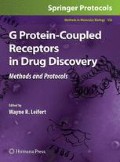Summary
The C-termini of G protein-coupled receptors (GPCRs) interact with specific kinases and arrestins in an agonist-dependent manner suggesting that conformational changes induced by ligand binding within the transmembrane domains are transmitted to the C-terminus. Förster resonance energy transfer (FRET) can be used to monitor changes in distance between two protein domains if each site can be specifically and efficiently labeled with a donor or acceptor fluorophore. In order to probe GPCR conformational changes, we have developed a FRET technique that uses site-specific donor and acceptor fluorophores introduced by two orthogonal labeling chemistries. Using this strategy, we examined ligand-induced changes in the distance between two labeled sites in the β2 adrenoceptor (β2-AR), a well-characterized GPCR model system. The donor fluorophore, Lumio™Green, is chelated by a CCPGCC motif [Fluorescein Arsenical Helix or Hairpin binder (FlAsH) site] introduced through mutagenesis. The acceptor fluorophore, Alexa Fluor 568, is attached to a single reactive cysteine (C265). FRET analyses revealed that the average distance between the intracellular end of transmembrane helix (TM) six and the C-terminus of the β2-AR is 62 Å. This relatively large distance suggests that the C-terminus is extended and unstructured. Nevertheless, ligand-specific conformational changes were observed (1). The results provide new insight into the structure of the β2-AR C-terminus and ligand-induced conformational changes that may be relevant to arrestin interactions. The FRET labeling technique described herein can be applied to many GPCRs (and other membrane proteins) and is suitable for conformational studies of domains other than the C-terminus.
Access this chapter
Tax calculation will be finalised at checkout
Purchases are for personal use only
References
Granier, S., Kim, S., Shafer, A. M., Ratnala, V. R., Fung, J. J., Zare, R. N., and Kobilka, B. (2007) Structure and conformational changes in the C-terminal domain of the beta2-adrenoceptor: Insights from fluorescence resonance energy transfer studies. J. Biol. Chem. 282, 13895–13905.
Ji, T. H., Grossmann, M., and Ji, I. (1998) G protein-coupled receptors. I. Diversity of receptor-ligand interactions. J. Biol. Chem. 273, 17299–17302.
Swaminath, G., Xiang, Y., Lee, T. W., Steenhuis, J., Parnot, C., and Kobilka, B. K. (2004) Sequential binding of agonists to the beta2 adrenoceptor. Kinetic evidence for intermediate conformational states. J. Biol. Chem. 279, 686–691.
Ghanouni, P., Gryczynski, Z., Steenhuis, J. J., Lee, T. W., Farrens, D. L., Lakowicz, J. R., and Kobilka, B. K. (2001) Functionally different agonists induce distinct conformations in the G protein coupling domain of the beta2 adrenergic receptor. J. Biol. Chem. 276, 24433–24436.
Ghanouni, P., Steenhuis, J. J., Farrens, D. L., and Kobilka, B. K. (2001) Agonist-induced conformational changes in the G protein-coupling domain of the beta2 adrenergic receptor. Proc. Natl. Acad. Sci. USA 98, 5997–6002.
Benovic, J. L. (2002) Novel beta2-adrenergic receptor signaling pathways. J. Allergy Clin. Immunol. 110, S229–S235.
Reiter, E., and Lefkowitz, R. J. (2006) GRKs and beta-arrestins: roles in receptor silencing, trafficking and signaling. Trends Endocrinol. Metab. 17, 159–165.
Lefkowitz, R. J., and Shenoy, S. K. (2005) Transduction of receptor signals by beta-arrestins. Science 308, 512–517.
Ren, X. R., Reiter, E., Ahn, S., Kim, J., Chen, W., and Lefkowitz, R. J. (2005) Different G protein-coupled receptor kinases govern G protein and beta-arrestin-mediated signaling of V2 vasopressin receptor. Proc. Natl. Acad. Sci. USA 102, 1448–1453.
Azzi, M., Charest, P. G., Angers, S., Rousseau, G., Kohout, T., Bouvier, M., and Pineyro, G. (2003) Beta-arrestin-mediated activation of MAPK by inverse agonists reveals distinct active conformations for G protein-coupled receptors. Proc. Natl. Acad. Sci. USA 100, 11406–11411.
Rasmussen, S. G., Choi, H. J., Rosenbaum, D. M., Kobilka, T. S., Thian, F. S., Edwards, P. C., Burghammer, M., Ratnala, V. R., Sanishvili, R., Fischetti, R. F., Schertler, G. F., Weis, W. I., and Kobilka, B. K. (2007) Crystal structure of the human beta2 adrenergic G protein-coupled receptor. Nature 450, 383–387.
Rosenbaum, D. M., Cherezov, V., Hanson, M. A., Rasmussen, S. G., Thian, F. S., Kobilka, T. S., Choi, H. J., Yao, X. J., Weis, W. I., Stevens, R. C., and Kobilka, B. K. (2007) GPCR engineering yields high-resolution structural insights into beta2-adrenergic receptor function. Science 318, 1266–1273.
Ha, T., Ting, A. Y., Liang, J., Caldwell, W. B., Deniz, A. A., Chemla, D. S., Schultz, P. G., and Weiss, S. (1999) Single-molecule fluorescence spectroscopy of enzyme conformational dynamics and cleavage mechanism. Proc. Natl. Acad. Sci. USA 96, 893–898.
Chen, R. F. (1965) Fluorescence quantum yield measurements: vitamin B6 compounds. Science 150, 1593–1595.
Magde, D., Wong, R., and Seybold, P. G. (2002) Fluorescence quantum yields and their relation to lifetimes of rhodamine 6G and fluorescein in nine solvents: improved absolute standards for quantum yields. Photochem. Photobiol. 75, 327–334.
Acknowledgment
S.G. thanks Brian Kobilka for his constant support and for the supervision of this project.
Author information
Authors and Affiliations
Editor information
Editors and Affiliations
Rights and permissions
Copyright information
© 2009 Humana Press, a part of Springer Science+Business Media, LLC
About this protocol
Cite this protocol
Granier, S., Kim, S., Fung, J.J., Bokoch, M.P., Parnot, C. (2009). FRET-Based Measurement of GPCR Conformational Changes. In: Leifert, W. (eds) G Protein-Coupled Receptors in Drug Discovery. Methods in Molecular Biology, vol 552. Humana Press, Totowa, NJ. https://doi.org/10.1007/978-1-60327-317-6_18
Download citation
DOI: https://doi.org/10.1007/978-1-60327-317-6_18
Published:
Publisher Name: Humana Press, Totowa, NJ
Print ISBN: 978-1-60327-316-9
Online ISBN: 978-1-60327-317-6
eBook Packages: Springer Protocols

